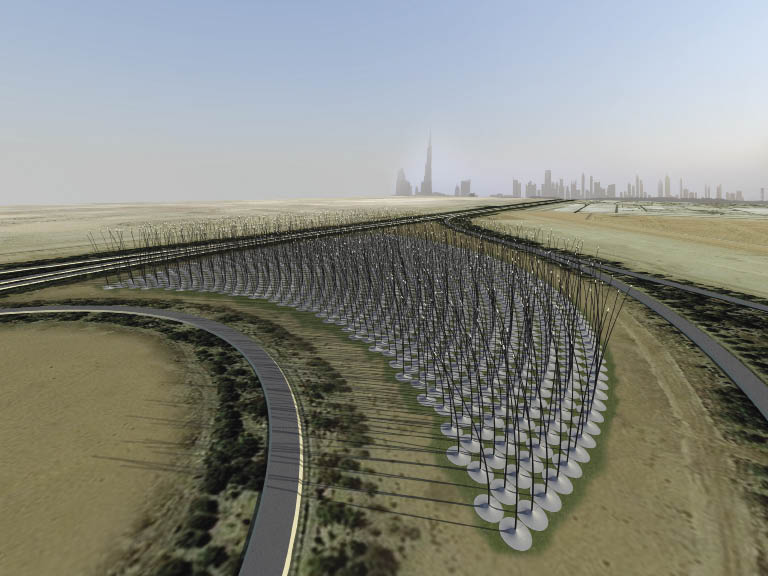What do you get when you combine an architect, engineer, biologist, ecologist, and a poet? A winning entry. The Windstalk, conceived by New York collaborative design studio Atelier DNA, placed second in an international competition. Dario Nunez-Ameni of the studio explains that communities often resist large projects as they may clash with the natural landscape. The Land Art Generator Initiative, however, considers large-scale land art installations that also produce clean energy. “While designing the project we were mindful that it had to be in a public space,” he says. “It harvests energy while serving as an inviting place to be.”
The Windstalk is the product of biomimicry, “taking clues” from designs already found in nature, such as the wind swaying a field of wheat or reeds. It consists of 1,203 stalks with concrete bases. The 50-m tall stalks are carbon-fiber reinforced resin poles. The top portion of each pole hosts an LED lamp that glows and dims according to how much the stalks sway.

An LED lamp tops each pole, glowing and dimming according to how much the poles sway in the wind. When there is no wind the poles are still and go dark. Visitors may traverse the site day or night by stepping on each pole base.
The pole bases lie along a site in a logarithmic spiral, “the kind we see in the center of a sunflower,” as the project’s description reads. “The bases all touch each other, forming a kind of carpet, a kind of fabric.” Each base is shaped like vortices, so when it rains, water slides down and collects in the spaces between. This concentrates scarce water and lets plants grow.
In this conceptual design, visitors may traverse the site by stepping on each base. As the narration describes, you can lean on the slopes, lie down, stay awhile and listen to the wind rushing between the poles. Each pole holds a stack of piezoelectric ceramic discs with electrodes between. Every other electrode is connected by a cable that reaches top to bottom of each pole. When the wind sways the poles, the stack of discs is forced into compression, hence generating a current through the electrodes.
Also, a torque generator in each base converts the kinetic energy of the swaying poles into electrical energy. The flow of generated electricity depends on the wind, so to compensate the site uses a capacitor. The designers estimate that the overall output of the project is comparable to that of a conventional turbine array. While a single 55-m turbine may produce more energy than one Windstalk, the latter can be packed in denser arrays. “Spacing and turbulence are concerns of most wind farms,” Nunez-Ameni says, “But our project thrives on chaos.”
Below the field of poles are two chambers as large as the whole site. When the wind blows, part of the generated electricity powers a set of pumps that move water from the lower chamber to the upper one. Likewise, when there is no wind energy the water from the upper chamber flows down again turning the pumps into generators.
The Windstalks’ shape should be optimized to behave as chaotically as possible, according to the design team. Simulations can help improve the profile for maximum movement and variation. The contest intends to help participants ultimately attract investment to con-struct power-generating plants that are functional and aesthetically pleasing to the landscape. Nunez-Ameni says the project was intended for a site in Dubai and hopes to see it built someday. WPE
Filed Under: News




